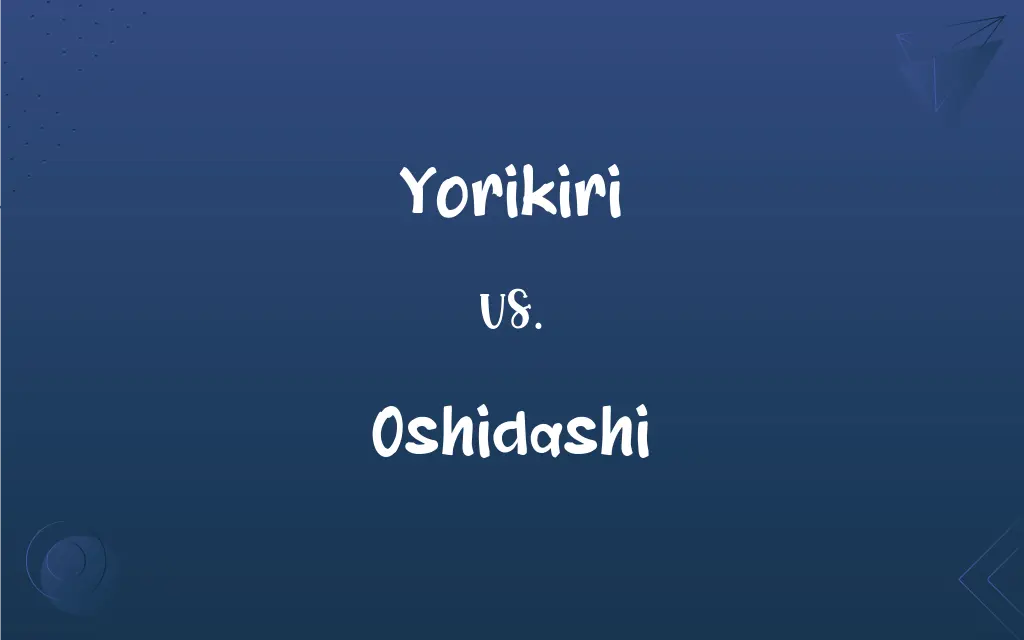Yorikiri vs. Oshidashi: What's the Difference?
Edited by Aimie Carlson || By Janet White || Updated on February 9, 2024
Yorikiri is a sumo wrestling technique where a wrestler forces their opponent out of the ring while holding their belt. Oshidashi involves pushing the opponent out without needing to grab the belt.

Key Differences
Yorikiri and oshidashi are both winning techniques in sumo wrestling, each with its distinct approach to defeating an opponent. Yorikiri, often seen in sumo matches, involves the wrestler getting a firm grip on the opponent's belt (mawashi) and using this hold to force them out of the ring. This technique emphasizes close contact and control over the opponent's movement.
Oshidashi, in contrast, does not require the wrestler to grab the belt. Instead, the wrestler pushes the opponent out of the ring using their hands and body. This technique relies on raw strength and the ability to unbalance or overpower the opponent without the need for a grip on the mawashi. Oshidashi is direct and can be executed swiftly, often catching the opponent off-guard.
The strategy and physical demands of yorikiri and oshidashi vary significantly. Yorikiri requires a wrestler to get close, establish a strong grip, and maintain control, often leading to a more prolonged and strategic battle. Oshidashi focuses on leverage, balance, and the application of force, potentially leading to quicker victories if executed effectively.
Both techniques are foundational to sumo wrestling, reflecting different aspects of the sport's physical and strategic demands. Yorikiri showcases endurance, grip strength, and the ability to maneuver an opponent, while oshidashi demonstrates explosive power and the capacity to dominate the physical space of the ring.
In training, sumo wrestlers develop the skills necessary for both yorikiri and oshidashi, along with other techniques. Mastery of these techniques is critical for success in the sport, with wrestlers often favoring one based on their physical attributes, fighting style, and strategic preferences. Each technique's successful execution is a testament to a wrestler's skill, strength, and tactical acumen.
ADVERTISEMENT
Comparison Chart
Definition
Forcing out of the ring with a belt grip.
Pushing out of the ring without a belt grip.
Technique Requirement
Grip strength and control.
Power and balance.
Strategy
Close contact and maneuvering.
Quick, direct force application.
Physical Demand
Endurance and tactical movement.
Explosive strength and speed.
Outcome
Often a longer, strategic match.
Can lead to swift victories.
ADVERTISEMENT
Yorikiri and Oshidashi Definitions
Yorikiri
Reflects the sumo's essence of balance and technique.
Yorikiri is the sumo's art at its finest.
Oshidashi
Relies on strength rather than grip.
Oshidashi requires explosive power.
Yorikiri
A sumo technique involving belt grip and force.
The wrestler won with a powerful yorikiri.
Oshidashi
Demonstrates dominance in the ring.
The match's highlight was a decisive oshidashi.
Yorikiri
Emphasizes control over the opponent.
His yorikiri showcased remarkable endurance.
Oshidashi
Shows the importance of balance in sumo.
Mastering oshidashi is about understanding leverage.
Yorikiri
A demonstration of strategic maneuvering.
The match ended in a classic yorikiri.
Oshidashi
Quick execution can surprise opponents.
His oshidashi was swift and unexpected.
Yorikiri
Requires maintaining grip until victory.
Achieving yorikiri demands grip strength.
Oshidashi
A sumo technique for pushing opponents out.
He secured the win through oshidashi.
Yorikiri
(sumo) A kimarite in which the attacker drives his opponent out backwards while maintaining a constant grip on his mawashi.
Oshidashi
(sumo) a kimarite in which the attacker pushes his opponent out of the ring, maintaining hand contact at all times
FAQs
What exactly is yorikiri?
Yorikiri is a sumo technique where a wrestler wins by forcing their opponent out of the ring with a belt grip.
Do all sumo wrestlers use yorikiri?
Most wrestlers are trained in yorikiri, but its use varies by individual strengths and match dynamics.
How is oshidashi performed?
Oshidashi involves pushing the opponent out of the sumo ring without grabbing the belt.
Is oshidashi considered a powerful move?
Yes, oshidashi is seen as a powerful move because it relies on strength and quick action.
Can yorikiri be countered easily?
Countering yorikiri requires skill and strength, as it involves breaking the opponent's grip.
What are the key skills for executing oshidashi?
Key skills include balance, speed, and the ability to apply force effectively.
How do sumo wrestlers train for oshidashi?
Training focuses on strength, speed, and technique to maximize pushing power.
Which technique is more common in sumo?
Both yorikiri and oshidashi are common, depending on the wrestlers' styles and strategies.
What makes yorikiri challenging to perform?
Securing and maintaining a grip while maneuvering an opponent out of the ring requires skill and endurance.
Which technique is faster to execute?
Oshidashi can be faster to execute due to its direct approach.
How does a wrestler decide between yorikiri and oshidashi?
The decision is based on the opponent's stance, the wrestler's strengths, and the match's flow.
How do fans react to yorikiri and oshidashi wins?
Fans appreciate both techniques for their display of skill and strength.
Does oshidashi require specific footwork?
Effective footwork is crucial to execute oshidashi successfully, ensuring balance and power.
Is yorikiri a defensive technique?
Yorikiri can be both offensive and defensive, depending on the match's context.
What physical attributes benefit yorikiri?
Grip strength, endurance, and the ability to control an opponent's movement are beneficial.
How do sumo tournaments record yorikiri and oshidashi wins?
Wins are recorded by the technique used, with both yorikiri and oshidashi being common kimarite (winning moves).
Can yorikiri and oshidashi be used outside of professional sumo?
While specific to sumo, the principles of balance, strength, and technique can apply in other martial arts.
Are there specific strategies to defend against oshidashi?
Defending against oshidashi involves maintaining balance and counteracting the push.
What is the best way to learn yorikiri and oshidashi?
Training under an experienced sumo coach and practicing regularly are the best approaches.
What is the historical significance of yorikiri in sumo?
Yorikiri is one of the oldest and most traditional winning techniques in sumo.
About Author
Written by
Janet WhiteJanet White has been an esteemed writer and blogger for Difference Wiki. Holding a Master's degree in Science and Medical Journalism from the prestigious Boston University, she has consistently demonstrated her expertise and passion for her field. When she's not immersed in her work, Janet relishes her time exercising, delving into a good book, and cherishing moments with friends and family.
Edited by
Aimie CarlsonAimie Carlson, holding a master's degree in English literature, is a fervent English language enthusiast. She lends her writing talents to Difference Wiki, a prominent website that specializes in comparisons, offering readers insightful analyses that both captivate and inform.































































